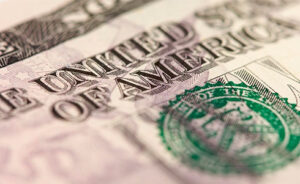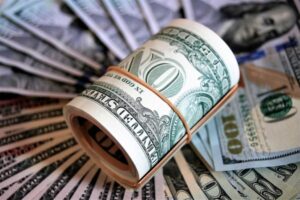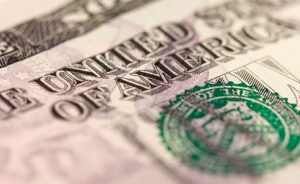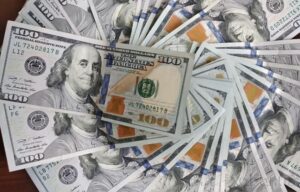
The U.S. dollar is strengthening against the euro, yen and pound sterling in trading on Tuesday on expectations that an unexpected decision by several OPEC+ states to cut production will prolong a period of high inflation in the world and delay the end of the cycle of monetary tightening by global central banks.
Such a decision could make it “a little more difficult” for the Federal Reserve (Fed) to deal with high inflation, said James Bullard, president of the Federal Reserve Bank (FRB) of St. Louis.
“This decision by oil-producing countries was unexpected, but whether it will have long-term consequences is an open question,” Bullard said in an interview with Bloomberg on Monday. – Oil prices fluctuate all the time, and it’s hard to track them accurately. Their rise will affect the rate of inflation and make our job a little more difficult.”
According to Bullard, the Fed’s benchmark interest rate, currently at 4.75-5%, should be raised to 5.5-5.75%.
The ICE-calculated index, which shows the dollar’s performance against six currencies (euro, Swiss franc, yen, Canadian dollar, pound sterling and Swedish krona), added 0.11% during Tuesday’s trading, while the broader WSJ Dollar Index added 0.15%.
The euro/dollar pair is trading at $1.0893 as of 9:20 a.m., up from $1.0905 at Monday’s market close.
The pound/dollar exchange rate is at $1.2407, compared to $1.2417 the day before.
The value of the U.S. currency in a pair with the yen increased to 132.76 yen against 132.42 yen at the end of the previous session.
The Australian dollar weakened to $0.6755 from $0.6786 a day earlier following the Reserve Bank of Australia’s (RBA) decision to halt the key interest rate hike.
The RBA kept Tuesday’s rate at 3.6 percent a year, its lowest since May 2012. The rate has been cumulatively raised by 350 bps since last May.
RBA governor Philip Lowe, however, warned that the central bank is ready to resume raising the rate if necessary.
“The RBA Board of Governors believes that further monetary policy tightening may be necessary to return inflation to the central bank’s target,” Lowe said in a statement posted on the RBA website. – Today’s decision to maintain the same rate level gives us time to assess the health of the economy and its prospects amid serious uncertainty.”

The dollar is getting cheaper against the euro, the yen and the pound sterling in trading on Friday due to improvement in traders’ mood and a decrease in demand for safe haven assets amid waning fears about the growing problems in the U.S. banking sector.
Earlier it became known that the American First Republic Bank, faced with the outflow of investors’ funds from deposits due to the situation with Silicon Valley Bank, received $30 billion in aid from 11 major U.S. banks, including JPMorgan Chase & Co. (SPB: JPM), Bank of America Corp. (SPB: BAC), Citigroup Inc. (SPB: C) and Wells Fargo & Co.
Moreover, the financial institutions said they have confidence “in banks of all sizes” and are willing to help them if necessary.
The news supported stock markets and other risky assets and helped weaken the U.S. dollar, Trading Economics noted.
The ICE-calculated index showing the dynamics of the dollar against six currencies (euro, Swiss franc, yen, Canadian dollar, pound sterling and Swedish krona) lost 0.34% in trading, while the broader WSJ Dollar Index lost 0.36%.
The euro/dollar pair is trading at $1.0650 as of 8:15 a.m., up from $1.0612 at market close on Thursday.
The day before, the European Central Bank (ECB) raised all three key interest rates by 50 basis points (bps), as planned, despite turbulence in the financial sector.
The ECB raised the benchmark lending rate to 3.5%, the deposit rate to 3% and the marginal lending rate to 3.75%.
In addition, the regulator lowered inflation forecasts in the eurozone for 2023-2025, and improved its GDP growth forecast for the current year.
ECB President Christine Lagarde said in a press conference after the meeting that the central bank has not abandoned its commitment to fighting high inflation, but in the current situation can’t talk about how key interest rates will change in the future.
The Federal Reserve (Fed) will hold its next meeting next week. Traders expect it to raise the rate by a maximum of 25 basis points, notes Bloomberg.
The cost of American currency in pair with yen fell to 133 yen during Friday’s trading against 133.75 yen by the end of the previous session.
Exchange rate of the pound to the dollar is $1.2157, compared to $1.2110 the day before.

The US dollar is moderately weakening in pairs with the euro and the pound sterling Thursday morning after a strong growth at the end of last session.
The index calculated by ICE which shows the US dollar dynamics against six currencies (euro, Swiss franc, yen, Canadian dollar, pound sterling and the Swedish krona), declined by 0.15% during the morning session. The day before, the indicator jumped 1 percent due to demand for defensive assets.
The euro/dollar pair was trading at $1.0601 as of 8:26 a.m. CC versus $1.0578 at the close of Wednesday’s session, with the euro adding about 0.2%.
The pound sterling is up 0.1% and is trading at $1.2070 versus $1.2057 at the close of last session.
The dollar-yen exchange rate is declining by 0.4% and is trading at 132.92 yen against 133.43 yen the day before.
Investors are waiting for the outcome of the March meeting of the European Central Bank, which will end on Thursday. Most analysts expect key interest rates to rise by 50 basis points.
Also, market participants continue to evaluate the data published a day earlier that retail sales in the USA declined 0.4% versus the previous month in February. At the same time, according to revised data, sales jumped 3.2% in January, the fastest pace since March 2021.
U.S. producer prices (PPI) rose 4.6% in February relative to the same month last year after jumping 5.7% in the first month of the year, the Labor Department said. On a month-over-month basis, the indicator declined 0.1% after rising 0.3% in January.
Many analysts now expect the Federal Reserve may leave interest rates unchanged at the end of its March meeting, although the consensus forecast still calls for a 25 basis point increase. At the same time, last week the markets allowed for a hike of 50 bps.

The U.S. dollar is strengthening against the euro, yen and pound sterling in trading on Tuesday after falling sharply the day before due to rising expectations that the Federal Reserve (Fed) will stop the cycle of raising the benchmark interest rate because of problems in the U.S. banking sector.
The futures market estimates less than 50% chance of Fed rate hike by 25 basis points (bps) at the March meeting, although last week traders considered the most likely scenario of rate hike at once by 50 bps, notes Bloomberg.
On Tuesday, traders’ attention is directed to the data on the dynamics of consumer prices in the U.S. for February, which is important for the Fed’s decision on the further rate level.
According to the experts’ consensus forecast, which is quoted by Trading Economics, inflation in the U.S. slowed down to 6% on an annualized basis last month from 6.4% a month earlier. Core inflation, which excludes food and energy costs, is expected to weaken to 5.5% from 5.6% in January.
The ICE-calculated index showing the dollar’s performance against six currencies (euro, Swiss franc, yen, Canadian dollar, pound sterling and Swedish krona) added 0.28% in trading, while the broader WSJ Dollar Index gained 0.23%.
The euro/dollar pair is trading at $1.0707 as of 8:10 a.m., up from $1.0734 at Monday’s market close.
The pound/dollar exchange rate is down to $1.2163 from $1.2184 the day before.
The value of the American currency in pair with the yen rose to 133.86 yen against 133.21 yen at the end of the previous session.
Yields on government bonds in Japan fell to a several-month low during Tuesday’s trading. Thus, the yield on 10-year government bonds fell to 0.24%, which is below the upper bound of the interest rate fluctuation corridor that was in effect until last December, when the Bank of Japan unexpectedly widened it to plus/minus 0.5%.
The dollar was down 0.9% against the euro, 1.2% against the pound and 1.3% against the yen on Monday.

The US dollar rate was almost unchanged against the euro and the pound sterling on Friday morning, but demonstrated an active rise in pair with the yen on the results of the Bank of Japan meeting.
The ICE-calculated index showing the U.S. dollar’s performance against six currencies (euro, Swiss franc, yen, Canadian dollar, pound sterling and Swedish krona) was down less than 0.1% during this morning’s session. The broader WSJ Dollar Index was up less than 0.1%.
The euro/dollar pair is trading at $1.0589 as of 8:00 a.m., versus $1.0585 at the close of Thursday’s session.
The pound sterling is trading at $1.1925 versus $1.1924 at the close of last session.
Foreign exchange market participants took a wait-and-see attitude ahead of Friday’s publication of statistical data on the U.S. labor market.
The Labor Department report will be released at 3:30 p.m. and analysts polled by Trading Economics expect it to show the unemployment rate will remain at 3.4 percent and the number of jobs in the U.S. economy will climb by 205,000.
Strong labor market data could be an important argument for the Fed to raise interest rates by 50 basis points at the March meeting. The market generally expects just such a scenario, although last week’s consensus forecasts called for a hike of just 25 bps.
Meanwhile, the dollar-yen exchange rate rose 0.4% to 136.65 yen against 136.14 yen the day before.
On Friday, the Bank of Japan expectedly didn’t change the main parameters of the monetary policy on the results of the meeting, which was the last for the head of the central bank Haruhiko Kuroda who heads the bank since 2013.
Japan’s parliament this week approved Kazuo Ueda as the next head of the central bank. He will lead the Bank of Japan on April 8, when Kuroda’s term expires. The next meeting will be held under his leadership on April 27-28.

The U.S. dollar is stable against the euro and the yen in trading on Tuesday and is weak against the pound.
The market is waiting for Federal Reserve (Fed) Chairman Jerome Powell’s semiannual report on monetary policy, which he will deliver before the Senate Banking Committee and the U.S. House Financial Services Committee on Tuesday and Wednesday, respectively.
Also this Friday, the U.S. unemployment figures for February will be released.
Powell is unlikely to say anything definitive about the further pace of the prime rate hike, since the key data that will affect the Fed’s decisions during the March meeting will be released after his remarks.
“The Fed wants to see more statistical data before it makes its next moves,” notes MacroPolicy Perspectives Chief Economist Laura Rosner-Whorbaton, quoted by Market Watch.
“Powell is likely to emphasize that the Fed still has a lot of work to do to fight inflation,” she says. – The Fed’s work is not over, and the central bank will continue to do it until it does it completely.”
The ICE-calculated index showing the dollar’s performance against six currencies (euro, Swiss franc, yen, Canadian dollar, pound sterling and Swedish krona) is losing 0.11% in trading, while the broader WSJ Dollar Index is adding 0.02%.
The euro/dollar pair is trading at $1.0685 as of 8:15 a.m., up from $1.0686 at Monday’s market close.
The pound/dollar exchange rate rose to $1.2040 from $1.2028 at the close of the previous session.
The U.S. currency pair with the yen rose to 135.94 yen from 135.92 yen the day before.
The rate of Australian dollar weakened to $0.6704 from $0.6730 at the close of previous trading session.
The Reserve Bank of Australia (RBA) on Tuesday raised its key interest rate by 25 basis points (bps) to 3.6% a year. This is the tenth increase in the cost of credit since last May, the rate was raised by 350 bps in total and is at its highest since May 2012.
Statement of the Australian Central Bank, however, was less “hawkish” than in the past, notes Market Watch. RBA stated that inflation in the country, probably, has already reached its peak level, and further decisions on tightening of monetary policy will depend on statistical data.